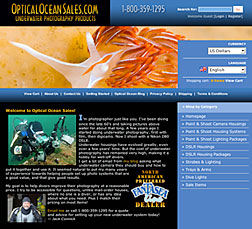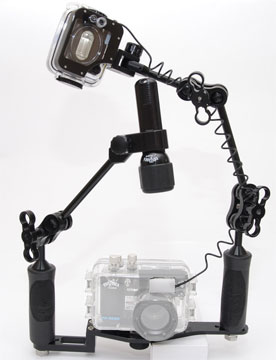Underwater Camera Floods: Avoiding the High Water Mark
Here are a few general tips on maintenance that should help you avoid finding Nemo in your housing:
1) Read the manufacturer’s instructions. Yeah, that little pamphlet you put your beer on while you unpacked your new baby. Wipe it off and carefully read through it. Housings all vary in care and feeding. For example, some housings use silicone gaskets that don't need silicone grease. Some o-rings are not removable but need to be wiped off. Some housings have controls that are user-serviceable, some don't. Just read it.
2) O-rings are probably the most important and miss-serviced parts. There are lots of the little buggers on uw cases. In addition to the large, noticeable o-ring on the back cover, every control has one or two, as well as the ports or strobe bulkheads. Some are black, some are blue, some should be serviced, and many should not.
Following rule #1, you can generally service the rear, port and bulkhead o-rings as follows. Remove them carefully by pinching the o-ring at the corner and pulling it out/off. If it sticks, use the corner of a credit card to gently pry it up. Your credit card will work great, since it won’t be of much use for anything else anyway after buying all of your photo gear. A blunted wooden cuticle remover also can also be useful, but do NOT use tweezers, screwdrivers, needle-nose pliers, vise grips or any other sharp, medieval devices.
Then just wash the o-ring in warm water with a bit of soap. Pat it dry completely with a lint-free dishtowel; NOT a paper towel or used Kleenex. Try not to stretch it as you dry it.
Examine the o-ring in a bright light. Use a magnifying glass if you're as old as I am. Look for dirt, cuts, dog, cat, rat, weasel and hamster hair. Be picky and meticulous; even the smallest hamster hair can ruin your day, and then you'll want to put the hamster in the housing and ruin his day. It really can get out of hand.
O-rings can get cut or abraded fairly easily as salt crystals form and slice them with their sharp edges. Replace them from your spares as necessary, and order replacements.
You do have fresh spares don't you? O-rings need to be stored in an air-tight bag away from strong sunlight. They get brittle with age, and should be periodically replaced.
If an o-ring is clean and in good shape, lubricate it with just a drop or two of the proper silicone grease. Do NOT use anything other than the grease that is from your housing manufacturer. For instance, using black o-ring grease on blue o-rings has been known to melt them, which generally results in you melting down when your housing floods.
Put a couple of drops on your fingertips and gently pull the o-ring through them to apply.
Now repeat the mantra; OMMM... "MORE IS NOT BETTER...MORE IS NOT BETTER...". Do NOT over grease. Silicone grease is ONLY a lubricant, NOT a sealant. All you want to see is sheen on the o-ring, not globs of grease. If you apply too much, all it will do is act as glue for sand and dirt to stick to.
3) Carefully clean the flanges and grooves where they contact the o-rings. Use foam swabs, or a cotton swab with a piece of lens tissue wrapped around the tip. Blowing them off carefully with a can of compressed air is ok, but try to blow the dirt OUT of the housing. Again examine all these surfaces carefully, they should not resemble "Beach Blanket Bingo" with sand everywhere, nor should there be any deep cuts or warping that would result in a bad seal. Do NOT apply grease to the flat surfaces.
4) Now carefully install the clean, greased o-rings, making sure they are not twisted and lay flat in their intended spots. If it seems out of shape, let it sit there for a minute, then try pressing it into place again. They can get heated and misshapen from your sweaty fingertips and enlarge slightly.
5) Install your camera with fresh batteries and carefully close your housing. Be sure that there's not a sync cord or the edge of a silica gel bag stuck in between the surfaces. If you have a clear housing, check to see that there is a solid line where the o-ring seals. Breaks in color usually mean hamster hair.
6) I wipe off copper electronic sync cord contacts with rubbing alcohol, and even use a bit of silicone grease on the threads when I install them. Then I leave the cord connected for the whole trip. The contacts are fragile and if it's working, it does not need to be serviced between dives. Covers need to be immediately put on sync cord ends; copper and salt air is a bad combination.
7) Be sure to try your installed camera with the strobe before you go diving. It’s easy to get something a little out of kilter, and nobody likes to hear bad words underwater.
8) A piece of thin sanitary pad usually fits in most housings and provides a bit of "oops a few drops got in" insurance. It’s a good idea to tape it and any silica gel packets in place with a bit of electrical tape. It’s really a bummer to see the words “Dry-z-Air” when you are trying to focus on a whale shark.
9) Always test your housing in the dunk tank on the boat. That's a plunge, swish-swish, watch for bubbles dunk...NOT a toss it in until I'm ready to dive dunk.
NEVER leave your camera in the rinse tank between dives, or for longer than a couple of minutes. MOST floods happen in the rinse tank. Cameras get dropped in on top of each other and latches get sprung, etc. Scratched ports are the least of your worries. Also, during your dive the housing and controls get compressed. Coming up from the bottom and then putting the camera in a non-pressurized tank of water can allow some controls to weep a bit. So just rinse it well, take it out and leave it under a towel between dives.
NEVER let anyone clean their mask out in the camera rinse tank. Anti-fog solutions have been known to be hard on o-rings. Gently prod the offender with your dive knife as you inform him of this fact, it’s usually effective.
10) Dried salt water is your housing’s enemy. Salt crystals form in the controls and they can cause leaks. If you don't have access to a fresh water rinse, leave it in salt water. As long as it doesn't dry, it's fine. Soak it thoroughly at home in warm fresh water.
Once a year or so you should send your housing into the manufacturer's repair center for servicing. Those small o-rings in the controls generally are not user-serviceable and need periodic replacement. Springs and controls get worn as well. Don't just pack the housing and take it on a long trip without checking the system on a test dive first.
The above doesn't have to take a long time, and a complete cleaning is not necessary every dive, but take your time and examine your housing carefully before you get in the water.
And watch out for those pesky hamsters.
--------------
Want to Make Sure? Considering a new housing? Just a thought (ok, shameless plug ;-) ). Fantasea housings come with 1 year of free flood insurance. When a customer has a problem, DEPP replaces their camera and Fantasea fixes or replaces the housing. Doesn't make up for a lost vacation, but it helps. The FP5000 for the CoolPix P5100 is an awesome combo.
--------------
Jack Connick is a Seattle diver and graphic designer who always wanted to be a photographer. He has traveled extensively around the world, logging over 800 dives in ten countries.
His company Optical Ocean Sales.com, is an authorized dealer for Fantasea Line and other underwater photography products.
Visit and join his free Cold Water Diving Flickr photo group.

















